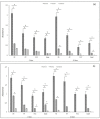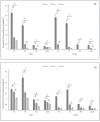Potential of Carvacrol and Thymol in Reducing Biofilm Formation on Technical Surfaces
- PMID: 34066411
- PMCID: PMC8125478
- DOI: 10.3390/molecules26092723
Potential of Carvacrol and Thymol in Reducing Biofilm Formation on Technical Surfaces
Abstract
Polyvinyl chloride (PVC), polypropylene (PP), polyethylene (PE), and stainless steel (SS) are commonly used in medicine and food production technologies. During contact with microorganisms on the surface of these materials, a microbial biofilm is formed. The biofilm structure is difficult to remove and promotes the development of pathogenic bacteria. For this reason, the inhibition of biofilm formation in medical and food production environments is very important. For this purpose, five naturally occurring compounds were used for antimicrobial screening tests. The two with the best antimicrobial properties were chosen to inhibit the biofilm formation of Staphylococcus aureus and Pseudomonas aeruginosa. After 3 days of exposure, thymol reduced the amount of biofilm of Pseudomonas aeruginosa within the range of 70-77% and 52-75% for Staphylococcus aureus. Carvacrol inhibited the formation of biofilms by up to 74-88% for Pseudomonas aeruginosa and up to 86-100% for Staphylococcus aureus. Those phenols decreased the enzyme activity of the biofilm by up to 40-100%. After 10 days of exposure to thymol, biofilm formation was reduced by 80-100% for Pseudomonas aeruginosa and by about 79-100% for Staphylococcus aureus. Carvacrol reduced the amount of biofilm by up to 91-100% for Pseudomonas aeruginosa and up to 95-100% for Staphylococcus aureus.
Keywords: biofilm formation; carvacrol; microbial adhesion; thymol.
Conflict of interest statement
The authors declare that there is no conflict of interest.
Figures




References
-
- Marić S., Vraneš J. Characteristics and significance of microbial biofilm formation. Period. Biol. 2007;109:115–121.
-
- Nandakumar V., Chittaranjan S., Kurian V.M., Doble M. Characteristics of bacterial biofilm associated with implant material in clinical practice. Polym. J. 2012;45:137–152. doi: 10.1038/pj.2012.130. - DOI
MeSH terms
Substances
Grants and funding
LinkOut - more resources
Full Text Sources
Molecular Biology Databases
Miscellaneous

